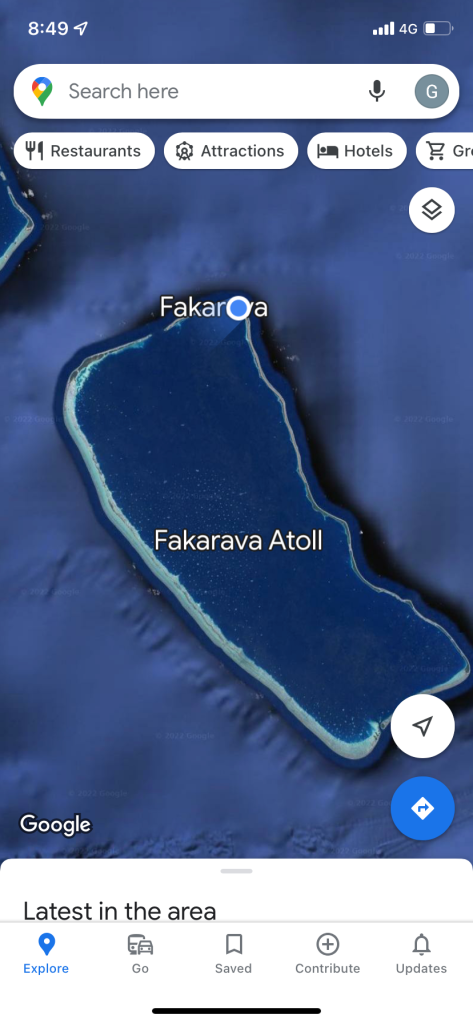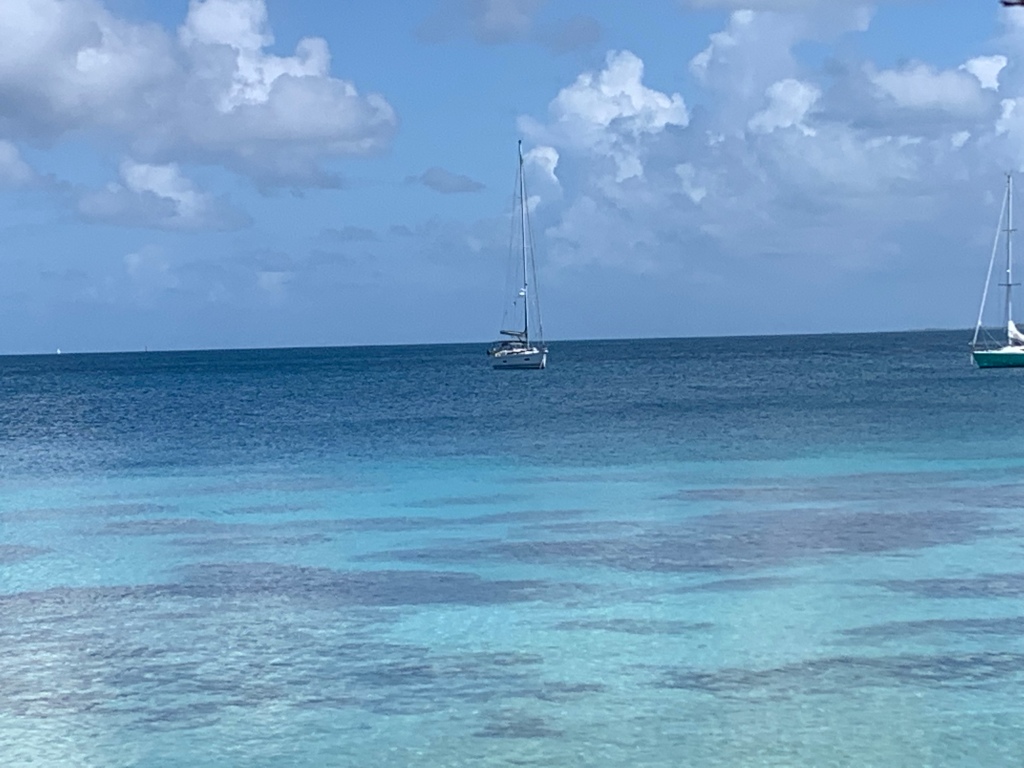This, the second largest atoll in the Tuomotus chain, is a magical spot. Only 37 miles long with a population around 600, it is known as one of the world’s premier SCUBA destinations. It’s highest point is around ten feet above sea level.
Atolls are formed by undersea volcanoes that rise above the ocean and eventually recede, leaving a coral ring surrounding a large lagoon with one or more entrances. The currents can run extremely fast as tidal and/or wind-driven seas rush in and out of the few small inlets.


On our last sail to the South Pacific, Travis and I had booked a dive in Fakarava while still in the Marquesas, but en route to the Tuomotus, our diesel engine failed, necessitating our diversion directly to Papeete, where we could get a mechanic. We sailed under autopilot within a few hundred yards of Fakarava, while both of us were below troubleshooting our fuel system. The dive company, Top Dive, gave us a credit, which we later used at their Papeete facility.
This time around, we were happy to be on someone else’s yacht with a functioning engine. Our entry through the atoll’s passage was uneventful, as we timed it to occur at slack tide. Knowing what I learned a few days later, while navigating Tiputa Pass on Rangiroa, our timing was pure, dumb luck.
Once safely anchored, we dinghied ashore, rented bikes, booked a dive for the next day, and explored. The most interesting site was the abandoned Topaka Lighthouse, an impressive structure near the airport resembling the Mayan ruins at Machu Picchu. There were several good restaurants on the atoll featuring French cuisine, which we enjoyed immensely after subsisting on Travis’s and my cooking during the 4-day passage from Fatu Hiva.


Our two dives were both held at the NE inlet, where strong currents and a steep drop off from the reef attract abundant marine life. Black-tip, nurse, and grey sharks were everywhere, as were schools of large barracuda and even a couple of inquisitive manta rays, which seemed to want to play with the divers as long as we were in the area. Seeing these graceful 10’ wide creatures, undulating close enough to touch, was otherworldly. We also saw an octopus fending off two attacking groupers. The octopus eventually discouraged its attackers by wedging itself into some coral.
Swimming with sharks sounds terrifying to most, but common reef sharks, such as white tip, black tip, grey. lemon, and nurse sharks generally have little interest in scuba divers. However, tiger sharks and hammerheads, which are generally much larger and aggressive than reef sharks, require more vigilance, and when they approach, one is cautioned to assume a vertical posture and an aggressive body language, lock eyes with the predator, and parry an attack by redirecting the shark’s head as it closes on the diver. Travis and I dove with hammerheads in Fiji last trip without losing any limbs. We were actually hoping to see tiger sharks in Fakarava, which our dive master regularly encounters, but were disappointed. Personally, I’m not sure how convincing my “aggressive body language” would appear to a 10’ tiger intent on biting me.
On a recent dive trip Travis took to Belize, he attracted a grey reef shark that evinced an unusual interest in him. The dive master saw the shark before Travis, and tapped on his own tank to alert him to the danger. Travis here exhibited good technique, kicking at the shark, maintaining eye contact, and acting aggressive, so the shark swam away.
The coral in Fakarava remains in excellent health, with just a bit of blanching, unlike that in much of the Caribbean. I first sailed the British Virgin Islands in the early ‘80’s, and everywhere I dove, reefs were vibrant and alive with color. In the past 20 years cruising that region, I’ve rarely found a reef that wasn’t totally blanched. A few fish nibble at what looks like old, bleached bones, devoid of color. Oceanographers generally agree that warming oceans are to blame, as well as tourists shedding sunscreen as increasing numbers snorkel these fragile ecosystems. The Great Barrier Reef is now 90% blanched, according to a recent study. I feel privileged, but terribly sad, that I am experiencing breathtakingly gorgeous ecosystems that may no longer exist in a few years.
Wow!! Amazing – great video. Keep ’em coming.
LikeLike
WordPress didn’t allow video during our last trip, now they do.
George E. Steinemann http://www.SailingNoreaster.com
>
LikeLike
Thank you for continuing to share, educate, and delight those of us following your magical adventure ❤️ I love the video showing how clear and beautiful the water is !!! …. Even though swimming with sharks sounds scary 😧
So very special that you and Travis are able to experience this together !!! What a Blessing 🙏🏻
LikeLike
Glad you enjoy following us. Travis has some incredible underwater video from our Rangiroa dives, but he needs to edit before I can post. You’ll love those.
George E. Steinemann http://www.SailingNoreaster.com
>
LikeLike
Tanks for the posts. Glad you are having a good (and safe) time. Rk
LikeLike
Thanks Rick. Headed to Papeete airport to fly home in an hour. It’s been fun but ready to sleep in a real bed again.
George E. Steinemann http://www.SailingNoreaster.com
>
LikeLike
George – This was the last posting I received. Where are you now (7/11)?
Really enjoyed your Trip notes – Norm
LikeLike